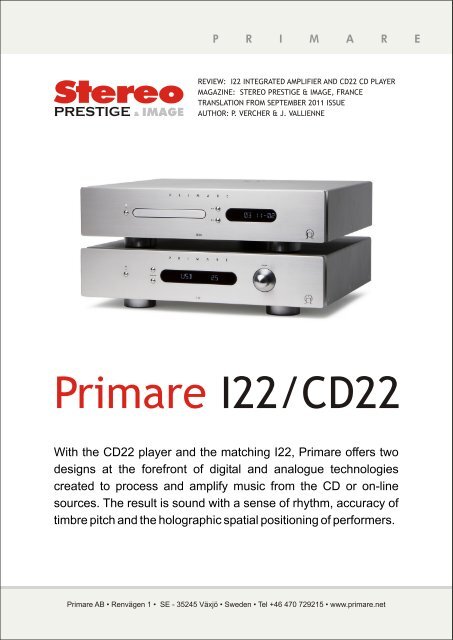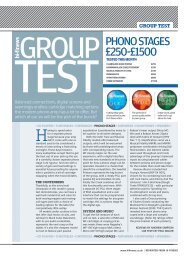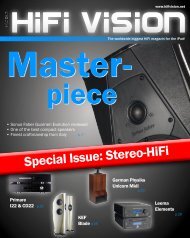PDF file - Primare
PDF file - Primare
PDF file - Primare
You also want an ePaper? Increase the reach of your titles
YUMPU automatically turns print PDFs into web optimized ePapers that Google loves.
P R I M A R E<br />
PRESTIGE &<br />
IMAGE<br />
REVIEW: I22 INTEGRATED AMPLIFIER AND CD22 CD PLAYER<br />
MAGAZINE: STEREO PRESTIGE & IMAGE, FRANCE<br />
TRANSLATION FROM SEPTEMBER 2011 ISSUE<br />
AUTHOR: P. VERCHER & J. VALLIENNE<br />
<strong>Primare</strong> I22/CD22<br />
With the CD22 player and the matching I22, <strong>Primare</strong> offers two<br />
designs at the forefront of digital and analogue technologies<br />
created to process and amplify music from the CD or on-line<br />
sources. The result is sound with a sense of rhythm, accuracy of<br />
timbre pitch and the holographic spatial positioning of performers.<br />
<strong>Primare</strong> AB • Renvägen 1 • SE - 35245 Växjö • Sweden • Tel +46 470 729215 • www.primare.net
P R I M A R E<br />
REVIEW: I22 INTEGRATED AMPLIFIER AND CD22 CD PLAYER<br />
This player/converter/amplifier system has proprietary technologies, which feature new power,<br />
filtering, conversion and amplification (see our chapters on technology by image) circuits. The<br />
result is a truly coherent sound aesthetic of great beauty without any auditory fatigue and with many<br />
opportunities to adapt to personal tastes.<br />
Listening Conditions<br />
We first listened to the I22 and the CD22 separately, then together, to determine their best operating<br />
conditions. First of all, and critically, the I22 requires a very long run-in period (as with all switchmode<br />
power supply and switching amplification) of about one week to deliver its full open, analytical<br />
abilities and optimal dynamic capacity.<br />
We stress this point because if you remove the I22 from the box and plug it in, you are unlikely to<br />
hear the potential of this amplifier. After run-in, it requires at least half an hour to stabilize its<br />
performance. After that, the choice of power leads is critical to get the best separation, precision of<br />
timbre and the layering of sounds. We used power cords from MIT, O2A and Silent Wire to replace<br />
the original. Interconnects with an upper-midrange emphasis must be avoided and the most neutral<br />
chosen to expose excellent dynamic capability. Finally, as far as speakers are concerned, we found<br />
that, without changing the sound character, the I22 is capable of driving the most complex loads<br />
with a disconcerting ease. Furthermore the I22 is quite astounding in its ability to retain bass quality<br />
and speed. The remarkable CD22 player was auditioned while making many comparisons between<br />
the various sampling frequencies it offers. The conclusions will go against many preconceived<br />
ideas. In general the 44.1 kHz frequency appears to offer the best spatial coherence, with robust,<br />
well-structured timbres. The higher the oversampling frequency, the more micro-information is<br />
defined, but at the cost of a little control over bass, dynamics, timbre accuracy and stereo width.<br />
Thus, at 192 kHz, rich micro-detail gives an impression of greater transparency: a quite ethereal<br />
character especially from large orchestral works, but with a slightly shortened stereo image width.<br />
To paraphrase the title of a Pirandello play, one is tempted to say "to each his own truth", but be<br />
aware, you must already have speakers with great definition to really appreciate these minute<br />
differences. In the end, we opted to listen at 44.1 kHz where all the parameters appeared the most<br />
balanced to us.<br />
Listen<br />
With the BWV70 Cantata by Bach, the <strong>Primare</strong> set reveals the entire character of the performance<br />
under the direction of John Eliot Gardiner, while distinguishing, with an extremely precise analytical<br />
capability, between the different instruments of the orchestra, in particular the trumpet and the<br />
reverberant oboe, whose pitch is finely in tune, without nasal effect. The chorus, in two sections that<br />
respond to each other, has a very warm tonal togetherness characterised by extremely rich textures<br />
that do not dry out through the upper-midrange. Given the complexity of the message for<br />
reproduction, the <strong>Primare</strong> CD22/I22 system gives a naturally faithful rendition without lapsing into<br />
<strong>Primare</strong> AB • Renvägen 1 • SE - 35245 Växjö • Sweden • Tel +46 470 729215 • www.primare.net
P R I M A R E<br />
REVIEW: I22 INTEGRATED AMPLIFIER AND CD22 CD PLAYER<br />
cold analysis. Even the most turbulent sequences of this cantata seem to flow with a fluidity, which is<br />
so removed from the disjointed character, of conventional switching amplifiers. One is struck by the<br />
quality of the bass vocal, by the warmth of its timbre and its humanity. Through the <strong>Primare</strong> system<br />
intelligibility is exceptional; the smallest dynamic intonations are revealed. In the third movement,<br />
the <strong>Primare</strong> set differentiates the pitch of viola and cello, preserving all the harmonic richness of<br />
these instruments, even with the marked differences in level. With increasing volume there is often<br />
a break-down of the timbral structure of stringed instruments that quickly becomes tiresome. The<br />
<strong>Primare</strong> system avoids all these problems with great distinction.<br />
There were more excellent surprises: in the monumental performance of Bach’s Toccata and<br />
Fugue, the organ rises with extraordinarily expressive power. Clearly the I22 has plenty in reserve:<br />
the sub bass is free of any artificial fullness. Indeed, with unusual clarity, extreme bass notes are<br />
beautifully wrought, expressing perfectly the dynamic capacity of the <strong>Primare</strong> system. In balancing<br />
direct and reflected sounds the effect of the nave of the Cathedral of Dresden can easily be<br />
detected.<br />
With the Sersé excerpt from Max Emmanuel Cencic, the <strong>Primare</strong> CD22/I22 system restores the<br />
voice of the counter-tenor exhibiting a warm, uncompressed and very natural evolution from lowmidrange<br />
to treble. Unlike many Class D switching amplifiers, the I22 does not react abruptly to<br />
strong level differences, and preserves the counter-tenor’s complex harmonic structure. He<br />
remains perfectly positioned relative to the orchestra. Again, we were surprised by the quality and<br />
sustain of the bass in the string sections, which remain un-blurred emphasising the grain of bristles<br />
on strings. Without accentuated effect in the upper midrange, the acoustics of the venue modulate<br />
naturally without becoming a reverberation chamber.<br />
When switching to a totally different musical genre: Yesterday, played by Shirley Horn, the <strong>Primare</strong><br />
system communicates the melancholy of the singer with a rare accuracy. Intonations are relayed<br />
with a completely warm aspect at odds with that of conventional switch-mode power supplies and<br />
switching power stages. In this respect, among others, we can detect the hard work of <strong>Primare</strong>’s<br />
engineers in developing switching circuits to overcome the problems of this technology. The<br />
presence of the voice is always warm and with a correct focus, good level balance with the beautiful<br />
<strong>Primare</strong> AB • Renvägen 1 • SE - 35245 Växjö • Sweden • Tel +46 470 729215 • www.primare.net
P R I M A R E<br />
REVIEW: I22 INTEGRATED AMPLIFIER AND CD22 CD PLAYER<br />
sound of the piano, perfectly stable in space. Again, the energy of the sub-bass communicates the<br />
deeply resonant character of the concert instrument. Similarly, the attack of the notes are well<br />
defined and continuous with those that follow.<br />
With the album Fourplay, the <strong>Primare</strong> system gives full force to the timpani beats that punctuate the<br />
introduction. It does justice to the sound of the mallet striking the huge stretched skin, then its<br />
relaxation, creating the characteristic pressure on the eardrums. The attack of Lee Ritenour's guitar<br />
is perfectly recognisable, the <strong>Primare</strong> system does not simplify it, but highlights it. We can raise the<br />
volume without concern. Hyper-dynamics and an exceptional sub-bass foundation are always in<br />
sync.<br />
With the introduction of Millénaire, and in an excerpt from Pôle Ouest by Michel Jonasz, the electric<br />
bass is portrayed with a great intensity: a real acoustic pressure and subjectively impressive. We<br />
ask how a 2 x 80 W amplifier can transcribe with such intensity and such transient speed the quality<br />
of low frequencies while retaining perfect control of the bass drivers in low output speakers as well<br />
as those with higher output. The voice of Michel Jonasz remains as a warmer, more convincing<br />
entity, devoid of nasal intonation. No wheezing or explosive passages are accentuated. Intelligibility<br />
is not disrupted by the effects of inter-modulation, despite the rather apocalyptic attack of the bass.<br />
Summary of the Sound Aesthetic<br />
<strong>Primare</strong>’s engineers truly have an exceptional<br />
mastery of digital and analogue circuit<br />
configuration. They prove it not only with the<br />
CD22 player’s quite exceptional analytical<br />
capability and well structured rendering of<br />
timbres, but also with the I22, defying all the<br />
prejudices regarding switch-mode power<br />
supplies and switching power levels. Thanks<br />
to their very interesting UFPD architecture<br />
(creating unconditional stability of operation<br />
regardless of the type of speakers) and the<br />
selection of sampling frequency from the<br />
CD22, the reproduction allows listening in<br />
complete serenity, without aggression, from<br />
these two perfectly matched electronics.<br />
Noise minimum at -130 dB, expect definition<br />
and dynamic capacity!<br />
<strong>Primare</strong> AB • Renvägen 1 • SE - 35245 Växjö • Sweden • Tel +46 470 729215 • www.primare.net
P R I M A R E<br />
REVIEW: I22 INTEGRATED AMPLIFIER AND CD22 CD PLAYER<br />
No spectrum of distortion during clipping for class D amplifiers.<br />
Spectrum of distortion at - 1 dB<br />
No trace of distortion measured in our conditions<br />
at 83 W.<br />
Square signal at 40 Hz<br />
Excellent result: Light filtering against the<br />
continuous (very low distortion and non-existent<br />
at 1 kHz).<br />
Measured specifications<br />
Effective power (8 ohms )<br />
2 x 105 W<br />
Pulse power (8 ohms )<br />
2 x 105 W<br />
Input sensitivity (nominal output power) 320 mV<br />
S/N ratio at nominal power<br />
>103 dBA (produced)<br />
S/N ratio for 1 W output<br />
> 83 dBA (produced)<br />
Square signal distortion 1 kHz 0 %<br />
<strong>Primare</strong> AB • Renvägen 1 • SE - 35245 Växjö • Sweden • Tel +46 470 729215 • www.primare.net
P R I M A R E<br />
REVIEW: I22 INTEGRATED AMPLIFIER AND CD22 CD PLAYER<br />
Technology By Image<br />
1 2 3 4 5<br />
CD Front View<br />
1 'Power / Standby' button.<br />
2 Loading tray.<br />
3 'Play / Skip' button. Pressing this starts playback if the CD is stopped. During playback,<br />
pressing this proceeds to the next track and holding it returns to the previous track.<br />
4 'Stop / Open' button. During playback, pressing this pauses the CD. Pressing it again stops<br />
the playback. Holding it controls the opening/closing of the tray.<br />
5 Multi-function display (track number, elapsed time, remaining time, etc.).<br />
1 2 3 4 5 6 7 8 9<br />
CD Rear View<br />
1 Asymmetric Cinch analog outputs.<br />
2 Cinch coaxial digital output.<br />
3 TosLink optical digital output.<br />
4 'Trigger' input and output: switch on and remote control.<br />
5 USB A input : connection with a USB key or hard drive, for example.<br />
6 RS-232 port (connection to a home automation system).<br />
7 Wired remote control input and output (repetition of infrared remote control).<br />
8 Main On / Off switch.<br />
9 Power cord and fuse connection.<br />
<strong>Primare</strong> AB • Renvägen 1 • SE - 35245 Växjö • Sweden • Tel +46 470 729215 • www.primare.net
P R I M A R E<br />
REVIEW: I22 INTEGRATED AMPLIFIER AND CD22 CD PLAYER<br />
Technology By Image<br />
Internal View of the CD22<br />
01 R-Core transformer for powering the digital audio stages, analogue audio and mechanics<br />
02 Switch-mode power supply for the processor level, monitoring and display<br />
03 Three different power supplies for analogue audio, digital audio and mechanics<br />
04 Filtering by 4 2200µF/50V capacitors plus three 2200µF/35V capacitors, and three chokes<br />
(inductors)<br />
05 Regulation of power supplies by circuits mounted on heat sinks<br />
06 'Hi-fi' player system (and not computer CD-Rom) from Asatech with Sanyo optical block<br />
07 Digital signal processor card<br />
08 Management and mechanical control circuits and signal extracted from the block with<br />
Mitsumi MM1669 circuit and Servo Toshiba circuit TC94 series including a buffer level of 5<br />
seconds. The data from the player or the USB are stored in memory and then extracted at<br />
a hyper-regular rate with an ultra-precise clock circuit. This fully asynchronous mode of<br />
operation largely eliminates the jitter and compensates for possible playback defects<br />
associated with shock (lack of data from the block after a shock)<br />
09 TMP92 32-bit microcontroller with USB interface for conversion to SPDIF<br />
10 Digital / analogue management card. The signals (SPDIF in symmetric AES / EBU form)<br />
pass through a galvanic isolation micro-transformer<br />
11 STC LE5204 microcontroller<br />
12 Burr-Brown SRC4392 sampling frequency converter circuit. It can work up to a frequency<br />
of 216kHz (192 kHz in the <strong>Primare</strong>). The working frequency (ie sampling of the signal) can<br />
be chosen by the user: 44.1 kHz (bypass), 48 kHz, 96 kHz or 192 kHz<br />
13 'DAC' Burr Brown PCM1792 converter, Delta Sigma, 24 bits / 192 kHz<br />
14 Current-voltage conversion and analogue outputs with operational amplifiers (OPA134)<br />
and discrete components (Mosfet transistors, current source). There is no capacitor in the<br />
signal path.<br />
<strong>Primare</strong> AB • Renvägen 1 • SE - 35245 Växjö • Sweden • Tel +46 470 729215 • www.primare.net
P R I M A R E<br />
REVIEW: I22 INTEGRATED AMPLIFIER AND CD22 CD PLAYER<br />
Technology By Image<br />
View of the optional DAC card<br />
1 USB interface (TAS 1020 24 bit/96 kHz)<br />
2 AK4113/24 bits/192 kHz digital receiver<br />
3 SRC Analog Devices AD1895 (24/192 kHz) frequency conversion circuit<br />
4 Burr Brown PCM 1792 (24/192 kHz) digital/analogue converter.<br />
<strong>Primare</strong> AB • Renvägen 1 • SE - 35245 Växjö • Sweden • Tel +46 470 729215 • www.primare.net
P R I M A R E<br />
REVIEW: I22 INTEGRATED AMPLIFIER AND CD22 CD PLAYER<br />
Technology By Image<br />
Internal view of the I22 without the card<br />
01 Switch-mode power supply card developed by <strong>Primare</strong>. These power supplies are of the<br />
PFC (Power Factor Control) type that control the mains for a pure sinusoidal signal, of the<br />
same frequency and without phase shift with respect to the power (avoids drawing more<br />
power than is necessary, unlike that produced by other types of power when a very strong<br />
spike in current causes a phase shift). Separate power supplies for power stages, those for<br />
pre-amps, those for standby<br />
02 Pre-amp card (optional DAC digital module removed)<br />
03 Source selection: switching by relay<br />
04 Buffer levels by op amplifiers<br />
05 National Semi Conductor LM 1972 volume control circuit (switched resistance<br />
microphones)<br />
06 74HC595D circuit register (asynchronous with a clock) that syncs the conversion stage of<br />
the PWM signal with the output stages in class D<br />
07 LVC 244 circuit buffer driver<br />
08 Power stage card in class D for switching. The digital signal feeds each channel’s MosFet<br />
power transistor (International Rectifier IRFI 4212H double transistors in each, designed<br />
specifically for Class D amplifiers). The pattern of this Class D amplifier was made and<br />
developed by engineers from <strong>Primare</strong>, it is called Ultra Fast Power Device (UFPD). It<br />
adopts a configuration circuit with gain adjustable to frequency and power requirements.<br />
This arrangement is stable. The usual distortions in the treble are absent<br />
09 Integration and filtering with choke and condenser<br />
10 Switching relay<br />
11 Output chokes to prevent the risk of over modulation.<br />
<strong>Primare</strong> AB • Renvägen 1 • SE - 35245 Växjö • Sweden • Tel +46 470 729215 • www.primare.net
P R I M A R E<br />
REVIEW: I22 INTEGRATED AMPLIFIER AND CD22 CD PLAYER<br />
Manufacturer Specifications<br />
I22 Amplifier<br />
Continuous power :<br />
Bandwidth :<br />
Harmonic distortion : < 0.05 %<br />
Signal/noise ratio :<br />
Number of analog inputs :<br />
Number of outputs :<br />
Optional digital card :<br />
Dimensions :<br />
Weight :<br />
CD 22<br />
Mechanics :<br />
Converter :<br />
Analog outputs :<br />
Output impedance :<br />
Digital outputs :<br />
Frequency response :<br />
S/N ratio (20Hz – 20kHz linear) :<br />
2 x 80 W/8 Ohms 2 x 160 W/4 Ohms<br />
10 Hz - 20 kHz – 0.5 dB<br />
95 dB<br />
4 assymetric Cinch<br />
1 fixed recording, 1 variable pre-amp<br />
Yes, the modules provided for France are originally<br />
equipped with this card Inputs : 1 x USB/B, 1 x optical<br />
Toslink, 1 coaxial Cinch<br />
43 x 42 x 10.6 cm<br />
10 kg<br />
Asatech 8210, Sanyo block<br />
1 x Burr-Brown PCM1792, 24/192 kHz<br />
1 assymetric Cinch, 2.1 Vrms<br />
100 Ohms<br />
1 x S/PDIF coaxial Cinch; 1 x optical TosLink<br />
20Hz – 20 kHz (+0/-0.5dB)<br />
-100dB<br />
Total harmonic distortion<br />
plus noise (20Hz – 20kHz) :





